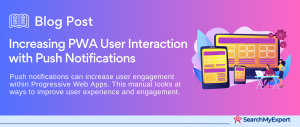Progressive Web App for Media and Content Platforms
The Emergence of Progressive Web Apps (PWAs)
In the rapidly evolving digital landscape, Progressive Web Apps (PWAs) stand as a groundbreaking innovation. These are web applications that utilize modern web capabilities to provide a user experience akin to native apps. PWAs bring together the best of both worlds – the wide reach of the web and the rich experience of native applications.
PWAs vs Traditional Web and Native Apps
Why Choose PWAs Over Traditional and Native Apps? Let’s break it down:
- Accessibility:
Unlike traditional web apps, PWAs are easily accessible, even in low-bandwidth areas or offline scenarios. - Speed: They load faster, thanks to service workers, providing an edge in user engagement.
- Cost-effective: Developing a PWA is often more budget-friendly compared to native apps, as it bypasses the need for different versions for various platforms.
The Game Changer for Media and Content Platforms
For media and content platforms, PWAs are a game-changer. They offer:
- Enhanced User Experiences: With features like push notifications, offline access, and fast load times, PWAs keep users engaged.
- Increased Engagement:
The app-like interface, combined with the ease of access of a web page, significantly boosts user retention. - Adaptability: PWAs adapt seamlessly across devices, ensuring a consistent experience for all users.
Advantages of PWAs for Media and Content Platforms
Improved Accessibility: Reaching a Wider Audience
PWAs: A Bridge Over Digital Divides
- Device and Browser Compatibility: PWAs function seamlessly across various devices and browsers, breaking the barriers of device-specific applications.
- No App Store Dependence: Users can access PWAs directly via a URL, bypassing the need for app store downloads and installations.
Faster Loading Times: The Speed Advantage
Service Workers: The Speed Boosters
- Instant Loading: Service workers, a core technology behind PWAs, enable almost instantaneous content loading, even with poor internet connections.
- Cache Management: PWAs store essential resources in cache, ensuring quick access and reduced data usage.
Offline Functionality: Always Connected, Even When Not
Offline Access: A Leap in User Experience
- Content Storage: PWAs can store content for offline viewing, an essential feature for users in areas with unreliable internet.
- Continuous Engagement:
This functionality ensures that the user experience is uninterrupted, increasing time spent on the platform.
Push Notifications: Engaging Users Directly
Direct Line to Users
- Increased Engagement:
Push notifications allow direct communication with users, promoting content and boosting platform engagement. - Personalization:
These notifications can be tailored to individual user preferences, making them more effective.
App-like Features: Enhancing Perceived Value
The Best of Both Worlds
- Home Screen Icons and Splash Screens: PWAs offer native app features like home screen icons and splash screens, enhancing user experience.
- App-like Interface:
The look and feel of PWAs mimic native apps, providing a high-value experience to users.
Core Features of a PWA for Media and Content Platforms
Dynamic Content Delivery: Personalization at Its Best
Adapting to User Preferences and Device Capabilities
- User-Centric Approach: PWAs can dynamically adapt content based on individual user preferences, enhancing the personalization of the experience.
- Responsive Design: They adjust seamlessly to various device capabilities, ensuring an optimal viewing experience across all platforms.
Seamless Content Discovery: A New World of Content at Your Fingertips
Intelligent Search and Curated Experiences
- Intelligent Search:
Advanced search capabilities in PWAs allow users to easily find the content they love. - Recommendations and Playlists:
Features like personalized recommendations and curated playlists guide users to discover new and relevant content.
Interactive Functionality: Building a Community
Engage, Share, and Connect
- Social Features:
Embedding social features such as comments and sharing options within PWAs fosters community engagement and interaction. - Real-Time Interaction: Users can interact with the content and with each other in real-time, adding a dynamic layer to the experience.
Monetization Strategies: Revenue Generation within the PWA Ecosystem
Diverse Revenue Streams
- Subscriptions:
Offering premium content through subscription models is a viable monetization strategy for PWAs. - In-App Purchases:
Users can access special features or content through in-app purchases. - Targeted Advertising: Integrating targeted advertising within PWAs can be an effective revenue source, thanks to the detailed user insights they provide.
Analytics and User Insights: The Backbone of Optimization
Understanding User Behavior for Better Content Delivery
- Tracking User Behavior:
Analytics within PWAs are crucial for understanding user interactions and preferences. - Optimization: Insights gained from user behavior data can be used to optimize content and features, enhancing overall user engagement.
Building a PWA for Media and Content Platforms
Progressive Web Apps (PWAs) have revolutionized the way we interact with digital media and content platforms. By leveraging the latest web technologies, PWAs offer a user experience that rivals native apps while maintaining the flexibility and accessibility of a website. This article dives into the core aspects of building a PWA for media and content platforms, focusing on development considerations, optimizing for mobile, and ensuring robust security and privacy.
Development Considerations: Technologies and Frameworks
Embracing Modern Web Technologies
To build an effective PWA, it’s crucial to utilize a blend of modern web technologies. Key players in this domain include:
- HTML5:
The backbone of any web application, providing structure and content. - CSS3:
For styling and visually engaging layouts. - JavaScript: Powers interactivity, with frameworks like React, Angular, or Vue.js enhancing the development process.
Leveraging Service Workers for Performance
Service workers are at the heart of PWAs, enabling offline functionality and resource caching. This leads to faster load times and a more consistent experience, even in fluctuating network conditions.
Utilizing Web App Manifests
A web app manifest is a JSON file that dictates how your PWA appears to the user. It allows you to control the home screen icons, splash screens, and more, ensuring your app feels truly “native.”
APIs for Enhanced Functionality
Incorporating APIs like Push API for notifications and Geolocation API for location-based services can significantly enhance user engagement.
Optimizing for Mobile: A Mobile-First Approach
Designing with Responsiveness in Mind
Media and content platforms must be visually appealing and functional across all devices. This calls for a responsive design that adapts to various screen sizes and orientations.
Touch Gestures and Navigation
Prioritize touch-friendly interfaces and intuitive navigation to cater to the primary mode of interaction on mobile devices.
Performance Optimization
Optimize images and media content for faster loading. Utilize lazy loading and consider network conditions to deliver content efficiently.
Security and Privacy: Building Trust
Implementing HTTPS
Ensure all data transmission is secure through HTTPS, protecting user data from interception and tampering.
Robust Authentication Mechanisms
Integrate strong authentication methods, like OAuth or biometric authentication, to safeguard user accounts.
Transparent Data Privacy Practices
Adhere to data privacy laws like GDPR or CCPA. Be transparent with users about how their data is collected, used, and protected.
Building a PWA for media and content platforms demands a strategic blend of modern technologies, a mobile-first approach, and a strong commitment to security and privacy. By focusing on these elements, developers can create immersive, efficient, and trustworthy digital experiences.
Case Studies and Success Stories
Progressive Web Apps (PWAs) have been a game-changer for media and content platforms. This article delves into real-life case studies, showcasing how PWAs have revolutionized these platforms with their successful features, and analyzing the tangible benefits in terms of user engagement, conversion rates, and revenue growth.
The Interactive News Portal
Successful Features:
- Rapid Load Times: Leveraged service workers for instant article loading.
- Push Notifications:
Kept users updated with real-time news alerts.
Impact:
- User Engagement: 60% increase in page views.
- Conversion Rate: 20% uplift in subscription sign-ups.
The Multimedia Streaming Service
Successful Features:
- Offline Accessibility:
Allowed downloading and viewing content offline. - Responsive Design:
Ensured a seamless experience across all devices.
Impact:
- User Retention: 50% reduction in bounce rate.
- Revenue Growth: 35% increase in premium membership enrollments.
The Educational E-Learning Platform
Successful Features:
- Interactive Learning Tools: Incorporated multimedia content for an engaging learning experience.
- Personalization:
Tailored content based on user preferences and learning history.
Impact:
- User Satisfaction:
90% positive user feedback. - Engagement Rate: 75% increase in daily active users.
These case studies exemplify how PWAs have transformed the media and content landscape, significantly enhancing user experience, engagement, and profitability. By adopting PWA technology, these platforms have not only improved their service offerings but also have set new benchmarks in user-centric digital experiences.
Future of PWAs in Media and Content Consumption: Navigating the Evolving Landscape
The landscape of Progressive Web Apps (PWAs) is rapidly evolving, shaping the future of media and content consumption. This article delves into the potential of PWAs to revolutionize this domain, exploring emerging trends like virtual reality (VR), augmented reality (AR), and offline-first experiences.
PWAs and Immersive Technologies: Blurring the Lines Between Real and Digital
Integrating VR and AR
- Enhanced User Experience: PWAs are poised to integrate VR and AR, offering immersive experiences that can transform storytelling and information dissemination.
- Broader Accessibility:
With PWAs, VR and AR experiences can become more accessible, bypassing the need for specialized apps.
Potential Applications
- News and Education:
Immersive learning experiences and interactive news stories. - Entertainment: Virtual concerts and movies with 360-degree experiences.
Offline-First Approach: Ensuring Constant Engagement
Embracing Offline-First
- Continuous Access: PWAs are increasingly adopting an offline-first approach, ensuring users have continuous access to content, even in low connectivity areas.
- Data Efficiency:
This approach also addresses data usage concerns, a critical factor in emerging markets.
Impact on Media Consumption
- Wider Reach: By allowing offline access, PWAs can reach a broader audience, including those in remote or low-bandwidth areas.
- Increased Engagement: Continuous access translates to increased user engagement and satisfaction.
The Road Ahead: Challenges and Opportunities
Addressing Technical Challenges
- Performance Optimization: As PWAs integrate more complex features like VR and AR, optimizing performance will be crucial.
- Cross-Platform Compatibility:
Ensuring consistent experiences across various devices and platforms remains a challenge.
Seizing Opportunities
- Innovative Storytelling: PWAs offer a platform for innovative, interactive storytelling methods.
- Global Reach:
With their wide accessibility, PWAs have the potential to reach global audiences, transcending geographical and technological barriers.
The future of PWAs in media and content consumption is bright, marked by continuous innovation and an ever-expanding array of possibilities. By harnessing emerging technologies and trends, PWAs are set to redefine how we experience and interact with digital content.
Embracing the Future with Progressive Web Apps
As we’ve explored throughout this article, Progressive Web Apps (PWAs) hold remarkable potential for media and content platforms. Their ability to blend the best of web and mobile app features presents a myriad of opportunities for businesses looking to enhance user experience and engagement. Here, we summarize the key advantages and encourage the adoption of this transformative technology.
Key Advantages of PWAs
- Enhanced User Experience:
PWAs offer a smooth, app-like interface with fast load times and offline capabilities, significantly improving the user experience. - Increased Reach and Engagement: Thanks to their accessibility on any device and the potential for offline use, PWAs can reach a wider audience, leading to higher engagement.
- Cost-Effective and Easy to Maintain:
Being web-based, they are easier and more cost-effective to develop and maintain compared to native apps. - Improved Conversion Rates and Revenue Growth: As evidenced by our case studies, PWAs have led to increased conversion rates and revenue growth for many platforms.
Encouraging Adoption
For Innovators and Leaders
If you are at the forefront of digital innovation, embracing PWAs can position your platform as a tech-savvy leader, offering cutting-edge solutions to your users.
For Startups and Small Businesses
PWAs provide an affordable yet effective solution to compete in the digital arena, enabling you to offer a premium user experience without the hefty investment of native app development.
For Established Platforms
Transitioning to a PWA can revitalize your user base, offering them a refreshed and more engaging way to interact with your content.
Conclusion
The adoption of PWAs represents not just a shift in technology, but a leap towards a more inclusive, engaging, and successful digital future. Whether you’re a startup, a small business, or an established content giant, exploring the potential of PWAs could be the key to unlocking new levels of user engagement and business success.
Transform your online strategy with leading Progressive Web App Service Companies.
Table of Contents
Toggle






